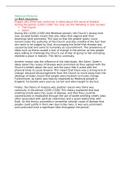Medieval Medicine:
12 Mark Questions:
Explain why there was continuity in ideas about the cause of disease
during the period c1250-c1500. You may use the following in your answer:
The Church
Galen
During the c1250-c1500 (the Medieval period), the Church’s strong hold
over societal beliefs meant that only ideas that aligned with their
teachings were promoted. This was so that the greater public could
remain under the authority of the Church and stay mindful of the fact that
sins were to be judged by God, encouraging the belief that disease was
caused by God and came to humanity as a punishment. The prevalence of
ideas such as these caused a lack of change in the period, as less people
were willing to challenge the Church out of fear of going to hell and being
rejected a place in heaven. This led to continuity.
Another reason was the influence of old individuals, like Galen. Galen’s
ideas about the causes of disease were promoted as they agreed with the
Church’s beliefs about the soul, and the ways that it acted with the
physical body to cause disease. This meant that there was a strong lack of
change, because discouragement from the Church to move away from the
ideology of Galen meant that people were hesitant to invoke change.
Furthermore, as Galen was heavily respected by Medieval people in
England, his beliefs were seen as correct and were taught to doctors.
Finally, the theory of miasma was another reason why there was
continuity in the period c1250-c1500. This theory explained that bad
smelling smells were the cause of disease, and that they could be
counteracted or eradicated through the use of sweet-smelling smells (also
often associated with spiritual cleanliness and a good relationship with
God). As this theory promoted a somewhat rational cause of disease that
people could justify in their own day to day lives, it was very prominent
and continued to be a significant idea throughout the period.
, Renaissance Medicine:
4 Mark Questions:
Explain one way that in which ideas about the treatment of disease were
different in the 17th century from ideas in the 13th century:
In the 13th century, ideas revolving around Hippocrates’ extremely popular
Theory of the Four Humours laid the foundation for societal beliefs on how
disease occurred. It was believed that the four humours (black bile,
choler, blood and phlegm) were the four basic elements of the human
body, and that an imbalance in them caused sickness. This was an
explanation that was heavily respected, and people’s reluctance to
change their ideas and innovate meant it stayed in place.
However, in the 17th century, this explanation was totally scrapped;
because of new thinkers and ‘scientists’ who were now readily exploring
the causes of disease, ideas such as miasma grew in more popularity, as
they still showed some basis of rational thinking, even though they were
wrong. The idea was that bad smelling air contained microbes that caused
disease, and that to protect yourself against disease, you should mask
yourself with sweet smelling smells. This was something heavily
promoted, especially by apothecaries.
Explain one way in which people’s responses to the 1665 Great Plague in
London were similar to the way that people reacted to the Black Death in
Britain:
During the Black Death, ideas about miasma and protecting yourself from
contagious people were extremely prevalent in society, encouraging
people to turn to herbal and floral methods to prevent disease. This was
extremely important and played a huge role in people’s responses to the
outbreak. For example, people would promote using sweet-smelling
smells to avoid the spread of bad-smelling smells that the plague brought,
and this was something that was again used in the Great Plague of 1665.
Here, plague doctors would have small bags, often full of herbal remedies
or flowers, and it believed to be a main protection against the Great
Plague. This shows continuity between the two time periods, and how
people’s responses were extremely similar.
Explain one way in which care in hospitals in the years c1250-c1500 was
different from care in hospitals in the years c1700-c1900:
In the years c1250-c1500 (the Medieval Period), hospitals existed as
places offering hospitality and rest to people, and often were only used by
travellers, as there was no real care offered by them, and most people
could make their own herbal remedies for treatment in their own homes,
as at the time, Britain was a very much ‘farming-based’ society. During
the Renaissance period, this idea of hospitals offering solely hospitality
and rest changed; this was greatly influenced by Florence Nightingale’s
work in the Crimean War, where her standards of cleanliness and the
creation of the ‘pavilion’ style wards meant that mortality rates dropped
form 40% to just 2%. Now, hospitals had great ventilation, and had wards
that separated infectious patients to those who were undergoing surgery.




